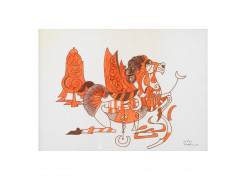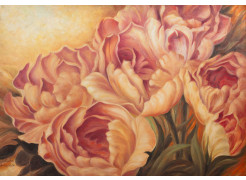Additional info:
Juliana Seraphim forged a distinctive visual vocabulary shaped by the experience of exile and the imaginative freedom of surrealism. After relocating to Lebanon with her family during the 1948 Palestinian displacement, she studied painting under the guidance of Jean Khalifé before enrolling at the Lebanese Academy of Fine Arts. Subsequent training in Florence and at the Royal Academy of San Fernando in Madrid refined her understanding of European modernism and deepened her sensitivity to Mediterranean light and form. Her compositions fuse the feminine and the grotesque in intricate, dreamlike spaces where figuration dissolves into transparency. Through densely layered imagery, she constructed a visual language of displacement, memory and desire. Dividing her life between Beirut and Paris, Seraphim maintained an active exhibition career and represented Lebanon in the Alexandria, Paris and São Paulo Biennials during the 1960s. Her works are now held in major public collections, including the Metropolitan Museum of Art in New York, the Institut du Monde Arabe and the Musée du Surréalisme in Paris, as well as the Sursock Museum in Beirut. Positioned within the wider narrative of Arab modernism, Seraphim’s practice articulates exile as both a psychological condition and a formal pursuit, merging personal mythology with collective history in a manner that resists categorisation and remains profoundly individual.
-
Vladimir Veličković
Belgrade, Serbia, 1935 - Split, Croatia, 2019 -
Sabin Bălașa
Dobriceni, Romania, 1932 - Bucharest, Romania, 2008 -
Vladinsky
b. Onești, Romania, 1988 -
Radu Dumitru
b. Puești, Valea Mare, Romania, 1957 -
Mikko Hintz
b. 1974




